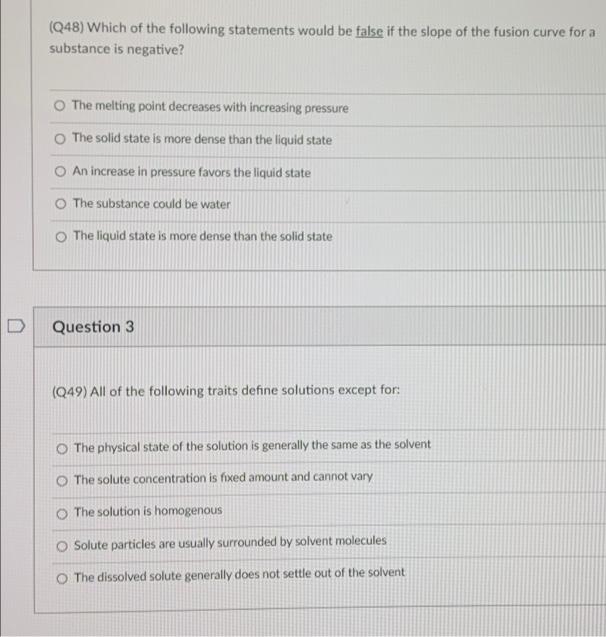(Q48) Which of the following statements would be false if the slope of the fusion curve for a substance is negative? O The melting polint decreases with increasing pressure O The solid state is more dense than the liquid state An increase in pressure favors the liquid state O The substance could be water O The liquid state is more dense than the solid state
(Q48) Which of the following statements would be false if the slope of the fusion curve for a substance is negative? O The melting polint decreases with increasing pressure O The solid state is more dense than the liquid state An increase in pressure favors the liquid state O The substance could be water O The liquid state is more dense than the solid state
Chemistry
10th Edition
ISBN:9781305957404
Author:Steven S. Zumdahl, Susan A. Zumdahl, Donald J. DeCoste
Publisher:Steven S. Zumdahl, Susan A. Zumdahl, Donald J. DeCoste
Chapter11: Properties Of Solutions
Section: Chapter Questions
Problem 2ALQ: Once again, consider Fig. 10-9. Suppose instead of having a nonvolatile solute in the solvent in one...
Related questions
Question

Transcribed Image Text:(Q48) Which of the following statements would be false if the slope of the fusion curve for a
substance is negative?
The melting point decreases with increasing pressure
The solid state is more dense than the liquid state
An increase in pressure favors the liquid state
O The substance could be water
O The liquid state is more dense than the solid state
Question 3
(Q49) All of the following traits define solutions except for:
O The physical state of the solution is generally the same as the solvent
O The solute concentration is fixed amount and cannot vary
O The solution is homogenous
O Solute particles are usually surrounded by solvent molecules
O The dissolved solute generally does not settle out of the solvent
Expert Solution
This question has been solved!
Explore an expertly crafted, step-by-step solution for a thorough understanding of key concepts.
This is a popular solution!
Trending now
This is a popular solution!
Step by step
Solved in 2 steps

Knowledge Booster
Learn more about
Need a deep-dive on the concept behind this application? Look no further. Learn more about this topic, chemistry and related others by exploring similar questions and additional content below.Recommended textbooks for you

Chemistry
Chemistry
ISBN:
9781305957404
Author:
Steven S. Zumdahl, Susan A. Zumdahl, Donald J. DeCoste
Publisher:
Cengage Learning

Chemistry: An Atoms First Approach
Chemistry
ISBN:
9781305079243
Author:
Steven S. Zumdahl, Susan A. Zumdahl
Publisher:
Cengage Learning


Chemistry
Chemistry
ISBN:
9781305957404
Author:
Steven S. Zumdahl, Susan A. Zumdahl, Donald J. DeCoste
Publisher:
Cengage Learning

Chemistry: An Atoms First Approach
Chemistry
ISBN:
9781305079243
Author:
Steven S. Zumdahl, Susan A. Zumdahl
Publisher:
Cengage Learning


Chemistry: Principles and Practice
Chemistry
ISBN:
9780534420123
Author:
Daniel L. Reger, Scott R. Goode, David W. Ball, Edward Mercer
Publisher:
Cengage Learning

Chemistry & Chemical Reactivity
Chemistry
ISBN:
9781337399074
Author:
John C. Kotz, Paul M. Treichel, John Townsend, David Treichel
Publisher:
Cengage Learning

Chemistry & Chemical Reactivity
Chemistry
ISBN:
9781133949640
Author:
John C. Kotz, Paul M. Treichel, John Townsend, David Treichel
Publisher:
Cengage Learning